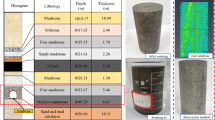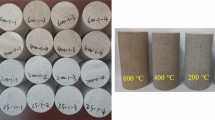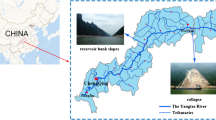Abstract
To study the fracture propagation and meso damage evolution law of saturated sandstone under unloading (unloading confining pressure), three unloading confining pressure tests of sandstone under different initial axial pressures were designed. By means of nuclear magnetic resonance (NMR) technology, the variation characteristics of rock porosity and T2 spectrum curves were analyzed, the relationship between damage degree and unloading confining pressure ratio was established, and the fractal characteristics of NMR were analyzed. The results show that: (1) The larger the initial axial compression, the larger the axial strain and the smaller the radial strain when unloading failure occurs. With the increase of unloading confining pressure ratio, the elastic modulus decreases, and the Poisson’s ratio and strain increase. (2) T2 spectrum peak shows that the pore size increases with the increase of unloading confining pressure ratio. The larger the initial axial compression, the larger the pore size. (3) Porosity increases exponentially with the increase of unloading confining pressure ratio, in which the number of micropores continues to increase, the number of mesopores and macropores first decreases and then increases. The initial axial pressure promotes the development and expansion of pores. (4) The relationship between pore characteristics, energy and damage degree is generally consistent, and the fractal characteristics of three sizes of pores show different changing rules with the increase of unloading confining pressure ratio.
Highlights
-
With the increase of unloading confining pressure ratio, the rock gradually changes from elastic deformation to plastic deformation.
-
The failure of the sample is caused by the sharp increase of the number and size of pores.
-
Porosity increases exponentially with the increase of unloading confining pressure ratio.
-
With the increase of unloading confining pressure ratio, the number of micropores continues to increase, and the number of mesopores and macropores first decreases and then increases.























Similar content being viewed by others
Data availability
The data that support the findings of this study are available on request from the corresponding author.
References
Alam MM, Hjuler ML, Christensen HF, Fabricius IL (2014) Petrophysical and rock-mechanics effects of CO2 injection for enhanced oil recovery: experimental study on chalk from south arne field, North Sea. J Petrol Sci Eng 122:468–487. https://doi.org/10.1016/j.petrol.2014.08.008
Al-Shalabi EW, Sepehrnoori K (2016) A comprehensive review of low salinity/engineered water injections and their applications in sandstone and carbonate rocks. J Petrol Sci Eng 139:137–161. https://doi.org/10.1016/j.petrol.2015.11.027
Barsanescu P (2015) Extension of Mohr–Coulomb theory for ductile materials. Exp Mech 55(7):1389–1393. https://doi.org/10.1007/s11340-015-0026-0
BV (2005) Statistical analysis of the influence of water content on the strength of the miocene limestone. Rock Mech Rock Eng. https://doi.org/10.1007/s00603-004-0034-3
Chen Y, Zuo J, Li Z, Dou R (2020) Experimental investigation on the crack propagation behaviors of sandstone under different loading and unloading conditions. Int J Rock Mech Min 130:104310. https://doi.org/10.1016/j.ijrmms.2020.104310
Chu ZF, Wu ZJ, Liu QS, Weng L, Wang ZY, Zhou Y (2021) Evaluating the microstructure evolution behaviors of saturated sandstone using NMR testing under uniaxial short-term and creep compression. Rock Mech Rock Eng 54(9):4905–4927. https://doi.org/10.1007/s00603-021-02538-4
Connolly PRJ, Yan W, Zhang D et al (2019) Simulation and experimental measurements of internal magnetic field gradients and NMR transverse relaxation times (T2) in sandstone rocks. J Petrol Sci Eng 175:985–997. https://doi.org/10.1016/j.petrol.2019.01.036
Dai B, Zhao G, Konietzky H, Wasantha PLP (2018) Experimental investigation on damage evolution behaviour of a granitic rock under loading and unloading. J Cent South Univ 25(5):1213–1225. https://doi.org/10.1007/s11771-018-3819-3
Ding Q, Ju F, Mao X, Ma D, Yu B, Song S (2016) Experimental investigation of the mechanical behavior in unloading conditions of sandstone after high-temperature treatment. Rock Mech Rock Eng 49(7):2641–2653. https://doi.org/10.1007/s00603-016-0944-x
Diyuan L, Zhi S, Quanqi Z, Kang P (2019) Triaxial loading and unloading tests on dry and saturated sandstone specimens. Appl Sci. https://doi.org/10.3390/app9081689
Duan K, Ji Y, Wu W, Kwok CY (2019) Unloading-induced failure of brittle rock and implications for excavation-induced strain burst. Tunn Undergr Sp Tech 84:495–506. https://doi.org/10.1016/j.tust.2018.11.012
Feng Q, Jiang B (2015) Analytical solution for stress and deformation of the mining floor based on integral transform. Int J Min Sci Technol 25(4):581–586. https://doi.org/10.1016/j.ijmst.2015.05.010
Fu J, Cao S, Song W, Tan Y (2017a) Creep analysis and delay time of instability of ultrahigh pillar considering initial imperfections. J China Univ Min Technol 46(02):279–284. https://doi.org/10.13247/j.cnki.jcumt.000645
Fu J, Song W, Tan Y (2017b) Criterion of local energy release rate of gob instability in deep mines considering unloading stress path. Int J Min Sci Technol 27(6):1011–1017. https://doi.org/10.1016/j.ijmst.2017.06.008
Fu J, Song W, Tan Y (2018) Study of stability and evolution indexes of gobs under unloading effect in the deep mines. Geomech Eng 14(5):439–451. https://doi.org/10.12989/gae.2018.14.5.439
Fu J, Wang J, Song W (2020) Damage constitutive model and strength criterion of cemented paste backfill based on layered effect considerations. J Market Res 9(3):6073–6084. https://doi.org/10.1016/j.jmrt.2020.04.011
Gao F, Wang Q, Deng H, Zhang J, Tian W, Ke B (2017) Coupled effects of chemical environments and freeze-thaw cycles on damage characteristics of red sandstone. B Eng Geol Environ 76(4):1481–1490. https://doi.org/10.1007/s10064-016-0908-0
Hou G, Liang J, Jing H, Tan J, Zhang Y, Yang X (2020a) Experimental study on deformation and acoustic emission characteristics of arch roadway under different unloading rates. Adv Civ Eng. https://doi.org/10.1155/2020/8818242
Hou G, Liang J, Jing H et al (2020b) Influence of deviatoric stress on the deformation and damage evolution of surrounding rock under unloading conditions. Shock Vib. https://doi.org/10.1155/2020/3158209
Hou ZY, Hao CB, Xiao FK, Liu G (2021) Research on energy conversion and damage features of unloading instability of sandstone under high stress. Adv Civ Eng. https://doi.org/10.1155/2021/6655968
Hu Z, Zhou K, Li J, Gao F, Wang M (2014) Meso-damage evolution of unloading rock mass based on nuclear magnetic resonance technology. Chin J Eng 36(12):1567–1574. https://doi.org/10.13374/j.issn1001-053x.2014.12.001
Hu JH, Ren QF, Yang DJ et al (2020) Cross -scale characteristics of backfill material using NMR and fractal theory. Trans Nonferr Metal Soc 30(5):1347–1363. https://doi.org/10.1016/S1003-6326(20)65301-8
Huang RQ, Huang D (2014) Evolution of rock cracks under unloading condition. Rock Mech Rock Eng 47(2):453–466. https://doi.org/10.1007/s00603-013-0429-0
Huang D, Li Y (2014) Conversion of strain energy in triaxial unloading tests on marble. Int J Rock Mech Min 66:160–168. https://doi.org/10.1016/j.ijrmms.2013.12.001
Kang P, Jing Z, Quanle Z, Xiao S (2020) Deformation characteristics of granites at different unloading rates after high-temperature treatment. Environ Earth Sci 79(13):343. https://doi.org/10.1007/s12665-020-09088-y
Li D, Zhao F, Zheng M (2014) Fractal characteristics of cracks and fragments generated in unloading rockburst tests. Int J Min Sci Technol 24(6):819–823. https://doi.org/10.1016/j.ijmst.2014.10.014
Li X, Chen Z, Weng L, Li C (2019) Unloading responses of pre-flawed rock specimens under different unloading rates. T Nonferr Metal Soc 29(7):1516–1526. https://doi.org/10.1016/S1003-6326(19)65059-4
Li H, Zhong Z, Eshiet KI, Sheng Y, Liu X, Yang D (2020) Experimental investigation of the permeability and mechanical behaviours of chemically corroded limestone under different unloading conditions. Rock Mech Rock Eng 53(4):1587–1603. https://doi.org/10.1007/s00603-019-01961-y
Lin Y, Zhou K, Li J, Ke B, Gao R (2020) Weakening laws of mechanical properties of sandstone under the effect of chemical corrosion. Rock Mech Rock Eng 53(4):1857–1877. https://doi.org/10.1007/s00603-019-01998-z
Lyu C, Ning Z, Cole DR, Wang Q, Chen M (2020) Experimental investigation on T2 cutoffs of tight sandstones: comparisons between outcrop and reservoir cores. J Petrol Sci Eng 191:107184. https://doi.org/10.1016/j.petrol.2020.107184
Martini F, Borsacchi S, Geppi M, Tonelli M, Ridi F, Calucci L (2018) Monitoring the hydration of MgO-based cement and its mixtures with portland cement by 1H NMR relaxometry. Micropor Mesopor Mat 269:26–30. https://doi.org/10.1016/j.micromeso.2017.05.031
Meng Q, Zhang M, Han L, Pu H, Nie T (2016) Effects of acoustic emission and energy evolution of rock specimens under the uniaxial cyclic loading and unloading compression. Rock Mech Rock Eng 49(10):3873–3886. https://doi.org/10.1007/s00603-016-1077-y
Nasharuddin R, Luo G, Robinson N, Fourie A, Johns ML, Fridjonsson EO (2021) Understanding the microstructural evolution of hypersaline cemented paste backfill with low-field NMR relaxation. Cement Concrete Res 147:106516. https://doi.org/10.1016/j.cemconres.2021.106516
Olatinsu OB, Olorode DO, Clennell B, Esteban L, Josh M (2017) Lithotype characterizations by nuclear magnetic resonance (NMR): a case study on limestone and associated rocks from the Eastern Dahomey Basin, Nigeria. J Afr Earth Sci 129:701–712. https://doi.org/10.1016/j.jafrearsci.2017.02.005
Shen Y, Wang Y, Wei X, Jia H, Yan R (2020) Investigation on meso-debonding process of the sandstone-concrete interface induced by freeze-thaw cycles using NMR technology. Constr Build Mater 252:118962. https://doi.org/10.1016/j.conbuildmat.2020.118962
Song Y, Yang H, Tan H, Ren J, Guo X (2021) Study on damage evolution characteristics of sandstone with different saturations in freeze-thaw environment. Chin J Rock Mech Eng 40(08):1513–1524. https://doi.org/10.13722/j.cnki.jrme.2021.0089
Teng T, Peng G (2020) Experimental and theoretical study on the compression characteristics of dry/water-saturated sandstone under different deformation rates. Arab J Geosci. https://doi.org/10.1007/s12517-020-05552-y
Wan CZ, Ting TW, Guo SJ, Da CZ (2010) The study on fractal damage of rock under hydraulic fracturing basing on conversation of energy. Appl Mech Mater. https://doi.org/10.4028/www.scientific.net/amm.29-32.1363
Wang J, Fu J, Song W, Zhang Y, Wang Y (2020) Mechanical behavior, acoustic emission properties and damage evolution of cemented paste backfill considering structural feature. Constr Build Mater 261:119958. https://doi.org/10.1016/j.conbuildmat.2020.119958
Wang J, Zhang C, Fu J, Song W, Zhang Y (2021a) Effect of water saturation on mechanical characteristics and damage behavior of cemented paste backfill. J Market Res 15:6624–6639. https://doi.org/10.1016/j.jmrt.2021.11.078
Wang J, Fu J, Song W, Zhang Y (2021b) Mechanical properties, damage evolution, and constitutive model of rock-encased backfill under uniaxial compression. Constr Build Mater 285:122898. https://doi.org/10.1016/j.conbuildmat.2021.122898
Wang J, Fu J, Song W, Zhang Y, Wu S (2021c) Acoustic emission characteristics and damage evolution process of layered cemented tailings backfill under uniaxial compression. Constr Build Mater 295:123663. https://doi.org/10.1016/j.conbuildmat.2021.123663
Wang J, Fu J, Song W, Zhang Y (2022a) Effect of rice husk ash (RHA) dosage on pore structural and mechanical properties of cemented paste backfill. J Market Res 17:840–851. https://doi.org/10.1016/j.jmrt.2022.01.044
Wang J, Zhang Q, Song Z, Liu X, Wang X, Zhang Y (2022b) Microstructural variations and damage evolvement of salt rock under cyclic loading. Int J Rock Mech Min 152:105078. https://doi.org/10.1016/j.ijrmms.2022.105078
Wen T, Tang H, Ma J, Liu Y (2019) Energy analysis of the deformation and failure process of sandstone and damage constitutive model. Ksce J Civ Eng 23(2):513–524. https://doi.org/10.1007/s12205-018-0789-9
Xie H, Li L, Peng R, Ju Y (2009) Energy analysis and criteria for structural failure of rocks. J Rock Mech Geotech Eng 1(1):11–20. https://doi.org/10.3724/SP.J.1235.2009.00011
Xue J, Du X, Ma Q, Zhan K (2021) Experimental study on law of limit storage energy of rock under different confining pressures. Arab J Geosci 14(1):62. https://doi.org/10.1007/s12517-020-06398-0
Zhang HQ, Tannant DD, Jing HW, Nunoo S, Niu SJ, Wang SY (2015) Evolution of cohesion and friction angle during microfracture accumulation in rock. Nat Hazards 77(1):497–510. https://doi.org/10.1007/s11069-015-1592-2
Zhang D, Yang Y, Chu Y, Zhang X, Xue Y (2018) Influence of loading and unloading velocity of confining pressure on strength and permeability characteristics of crystalline sandstone. Results Phys 9:1363–1370. https://doi.org/10.1016/j.rinp.2018.04.043
Zhang C, Fu J, Song W, Du C, Fu H (2021a) High-volume ultrafine fly ash-cement slurry mechanical properties and strength development model establishment. Constr Build Mater 277:122350. https://doi.org/10.1016/j.conbuildmat.2021.122350
Zhang L, Cong Y, Meng F, Wang Z, Zhang P, Gao S (2021b) Energy evolution analysis and failure criteria for rock under different stress paths. Acta Geotech 16(2):569–580. https://doi.org/10.1007/s11440-020-01028-1
Zhao XG, Wang J, Cai M et al (2014) Influence of unloading rate on the strainburst characteristics of beishan granite under true-triaxial unloading conditions. Rock Mech Rock Eng 47(2):467–483. https://doi.org/10.1007/s00603-013-0443-2
Zhao F, Hu J, Yang Y, Xiao H, Ma F (2022) Cross-scale study on lime modified phosphogypsum cemented backfill by fractal theory. Minerals-Basel. https://doi.org/10.3390/MIN12040403
Zhou K, Hu Z, Li J, Gao F, Wang M (2014a) Study of marble damage evolution laws under unloading conditions based on nuclear magnetic resonance technique. Chin J Rock Mech Eng 33(S2):3523–3530. https://doi.org/10.13722/j.cnki.jrme.2014.s2.016
Zhou K, Hu Z, Gao F, Wang M, Yang Z (2014b) Study of marble damage laws under triaxial compression condition based on nuclear magnetic resonance technique. Rock Soil Mech 35(11):3117–3122. https://doi.org/10.16285/j.rsm.2014.11.008
Zhou K, Su S, Hu Z, Li J, Yang Z (2015) Experimental research into nuclear magnetic resonance in marble with different initial damages under unloading conditions. Rock Soil Mech 36(08):2144–2150. https://doi.org/10.16285/j.rsm.2015.08.003
Zhou K, Liu T, Hu Z (2018a) Exploration of damage evolution in marble due to lateral unloading using nuclear magnetic resonance. Eng Geol 244:75–85. https://doi.org/10.1016/j.enggeo.2018.08.001
Zhou C, Ren F, Zeng Q, Xiao L, Wang W (2018b) Pore-size resolved water vapor adsorption kinetics of white cement mortars as viewed from proton NMR relaxation. Cement Concrete Res 105:31–43. https://doi.org/10.1016/j.cemconres.2017.12.002
Zhou X, Pan X, Cheng H (2021a) The nonlinear creep behaviors of sandstone under the different confining pressures based on NMR technology. Rock Mech Rock Eng 54(9):4889–4904. https://doi.org/10.1007/s00603-021-02557-1
Zhou TB, Qin YP, Cheng J, Zhang XY, Ma QF (2021b) Study on damage evolution model of sandstone under triaxial loading and postpeak unloading considering nonlinear behaviors. Geofluids. https://doi.org/10.1155/2021/2395789
Zilong Z, Xin C, Wenzhuo C, Xibing L, Cheng X (2016) Influence of water content on mechanical properties of rock in both saturation and drying processes. Rock Mech Rock Eng. https://doi.org/10.1007/s00603-016-0987-z
Acknowledgements
This experimental work was financially supported by the National Key Research and Development Program of China (2022YFC2905003), the National Natural Science Foundation of China (Grant No. 52274109), the National Natural Science Foundation of China (Grant No. 51974012), and the Postdoctoral Science Foundation of China (2021M690361) for financial support.
Author information
Authors and Affiliations
Contributions
JF funding acquisition, writing – review & editing. WC investigation, methodology, writing – original draft. YT writing – review & editing. JW funding acquisition, writing – review & editing. WS funding acquisition, writing – review & editing, supervision.
Corresponding authors
Ethics declarations
Conflict of Interest
The authors declare that the work described has not been published before; that it is not under consideration for publication anywhere else; that its publication has been approved by all coauthors; that there is no conflict of interest regarding the publication of this article.
Additional information
Publisher's Note
Springer Nature remains neutral with regard to jurisdictional claims in published maps and institutional affiliations.
Rights and permissions
Springer Nature or its licensor (e.g. a society or other partner) holds exclusive rights to this article under a publishing agreement with the author(s) or other rightsholder(s); author self-archiving of the accepted manuscript version of this article is solely governed by the terms of such publishing agreement and applicable law.
About this article
Cite this article
Fu, J., Chen, W., Tan, Y. et al. Experimental Study on Pore Variation and Meso-Damage of Saturated Sandstone Under Unloading Condition. Rock Mech Rock Eng 56, 4669–4695 (2023). https://doi.org/10.1007/s00603-023-03293-4
Received:
Accepted:
Published:
Issue Date:
DOI: https://doi.org/10.1007/s00603-023-03293-4




